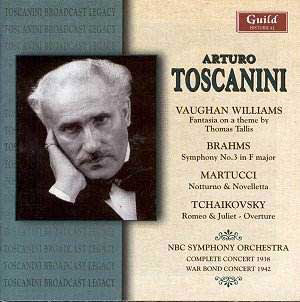This double CD set gives a good idea of that breadth
of musical sympathies which was a prime characteristic of Toscanini.
CD1 opens with a remarkable performance of the Vaughan
Williams Tallis Fantasia – on the face of it, one of the last
works you would associate with the fiercely passionate Italian maestro.
Yet this is a reading that has so many wonderful virtues. The string
playing is of the highest calibre, not only the large ensemble but the
solos as well. Toscanini keeps the music moving gently forward without
ever seeming to press uncomfortably, and he builds the climaxes with
all the burning intensity one would hope for. There are one or two patches
of mild radio interference, and perhaps the most disappointing thing
is the way the audience applause bursts in almost before the final pp
chord has faded to silence. Despite these small annoyances, this is
a performance that recreates the spirit of Vaughan Williams’ unique
work in an extraordinarily convincing way.
The same can be said of the Brahms Third Symphony that
follows. Again, one is aware of the superb quality of the instrumental
playing, which has the tightness of ensemble of chamber music. Toscanini
must be allowed some indulgences in his interpretation – the reduction
of the tone at 0:13 on Track 2 is an example, something that Brahms
does not specify – but Brahms is a composer he had an instinctive empathy
with. The first movement has an energy and alertness which captures
the colour and optimism of the music wonderfully, and once again, the
recording is sufficiently faithful to allow this to come through. It
is ‘top-heavy’, though, and places where the textural interest is located
in the middle or lower parts of the orchestra undoubtedly fare less
well than the fuller or more brightly scored passages. Toscanini’s gradation
of climaxes was always one of his greatest strengths, and the one in
the coda in this movement is thrilling.
The slow movement is unusually quick. Then again, it
is marked Andante – ‘walking pace’ if you like – and seems to
move very naturally at this speed. There is much lovely wind playing
and Toscanini allows himself a deeply expressive relaxing of the tempo
at the beginning of the coda – 6:02 – which allows the full beauties
of this, one of Brahms most glorious melodic flowerings, to be experienced
to the full. The Poco Allegretto has plenty of the required charm
without spilling over into coyness, while the finale is superbly done.
The main part of the movement has great forward thrust and stormy grandeur,
while the coda is magical; it sleep-walks its way to the soft conclusion,
yet the textures are lucid, transparent. This is great music-making,
and, for me, a deeply satisfying reading of the symphony, capturing
its unity of inspiration. Brahms never expressed himself more concisely
than here, and Toscanini understood this perfectly.
CD2 (once I had managed to get it out – when is somebody
going to DO something about the packaging of CDs?) is a more varied
selection. It begins with two short pieces by the Italian composer Giuseppe
Martucci, Notturno and Novelletta. Toscanini held Martucci
in high regard, and these are affectionate, beautifully phrased performances
of two attractive miniatures.
The orchestral playing is, if anything, even better
on CD2, four years on, and the recording likewise. Although, I must
say it was surprising to hear the percussion having a little spot of
difficulty with Tchaikovsky’s off-beat sword-fight rhythms in this otherwise
stunning performance of Romeo and Juliet. Where Toscanini shows
his greatness is in allowing the love music, in its resplendent reappearance,
to surge on with irresistible urgency, so that it is felt as the cause
of the violence that comes in its wake. The piece thus makes so much
better symphonic and dramatic sense than it can do in the hands of a
more sentimental, sensationalist conductor. Once again, Toscanini delivers
one of the shortest versions on disc, without seeming to rush the music
along.
The final couple of items on this second CD are obviously
make-weights in a fairly light concert programme. The symphony is given,
in all honesty, a pretty shoddy performance, and though the indestructible
character and invention of the music comes through, the orchestra sounds
under-rehearsed, and there are numerous rough edges. This is not helped
by a recording which fluctuates badly in pitch with a most disconcerting
effect, plus sound from another radio station which invades the quieter
portions of the music. Doesn’t help!
Despite that, this is a set which is well worth having
for the Vaughan Williams, Brahms and Tchaikovsky items, which receive
the vintage Toscanini treatment.
Gwyn Parry-Jones


